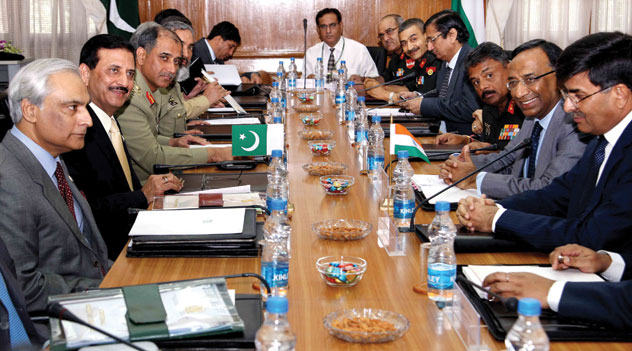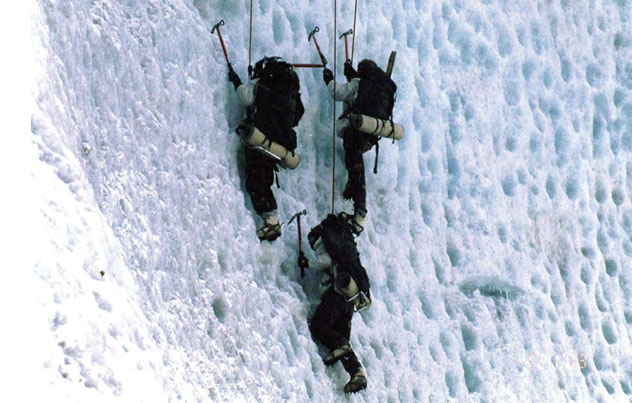POLITICS:
Talks Fail Again: Siachen Glacier Dispute
The battle over the rights to control the Siachen Glacier has seen many deaths, most of it due to the sheer wrath of mother Nature. The soldiers here have to face temparatures that are way below sub zero, and yet, the political dialogue between the two neighbors has so far been unperturbed even to such adverse situations, writes Siddharth Srivastava.

(Above): Defence Secretary Pradeep Kumar and his Pakistani counterpart, Lt. Gen. (Retd.) Syed Ather Ali at the Defence Secretary level talks, between India and Pakistan on Siachen issue, in New Delhi on May 30. [PRESS INFORMATION BUREAU]
Two day talks were held last month (May 30 and 31) between the defense secretaries of India and Pakistan on resolving the Siachen dispute that the two countries have wrangled about for many years.
The 12th round of interactions on the subject after a gap of three years ended without any perceptible progress though both sides agreed to carry on the “meaningful and result-oriented” discussions.
Indian Defense Minister A.K. Antony said the talks were “free and frank, but there was no conclusion or agreement. So ultimately, it was decided that more time was needed and discussions will continue in the 13th round.”
“It is a very complicated issue,” Antony added.
Situated along the India-Pakistan border, Siachen continues to be the world’s highest battlefield with India wielding control over most strategic posts on the glacier.
Thousands of soldiers have died not from gunfire, but because of severe weather conditions with temperatures dipping below minus 50 degree Celsius during winter.
India and Pakistan are estimated to have spent more than U.S. $10 billion guarding the Siachen glacier, with fatalities pegged at 2,300 troops dead, many from frostbite and pneumonia.
Over the last decade, despite major setbacks related to terror attacks such as Mumbai 26/11, India and Pakistan have made some progress in areas such as road, train and air links, sporting relations, easy visa norms and improved trade.
However, the glacier continues to be a hostile flashpoint with the growing presence of the Chinese Army in Pakistan for civilian and infrastructure works along the Kashmir border an additional cause of concern for India in the recent past.
The Siachen imbroglio is now also linked to an ‘unstable’ Pakistan with a vast terror network that needs to be dismantled before concrete steps of normalize relations between the two nations can possibly happen.
India’s armed forces have been uncomfortable about any deal with Pakistan on Siachen that could jeopardize the country’s security. The Indian Army faced the brunt of enemy fire from higher positions during the Kargil intrusion in 1999 in central Kashmir.
The Western Air Command that provides logistical support to the army in maintaining more than 5,000 troops on the glacier, where altitudes range between 4,500-7,500 meters has been the most vehement on the need for military presence at Siachen.
In multiple instances officials have made it clear the need to clearly demarcate boundaries before making any decision on demilitarizing the Siachen glacier.
India wants recognized on official maps of the two countries the location of the proposed 110-km long Actual Ground Position Line (AGPL) that would pass through the Soltoro Ridge and Siachen glacier.
In a comment, Air Chief Marshal P.V. Naik said last week, “We are at present at an advantageous position, by occupying certain heights where attacking is very difficult. If both the sides have to vacate this position, the AGPL needs to be marked and internationally approved, only then we will feel safe.”

(Above): Army jawans training at the Siachen Glacier camp. These jawans have to deal with temparatures as low as minus 50 degrees Centigrade, while talks that actually take place at comfortable room temparature, seem to go nowhere. [INDIAN ARMY]
About the Chinese presence in Pakistan Kashmir, Naik said, “this is a natural progression of the alliance between China and Pakistan.”
Pakistan, however, has repeatedly rejected the drawing of AGPL, saying that agreeing to it would be the same as accepting India’s control over the area.
Islamabad, however, wants de-militarization of Siachen and maintaining the pre-1972 troop position, as per the Shimla Agreement. In the recent past the country has also raised the issue of climate change and environmental damage to the area, issues that find resonance in global forums.
Until 1984, neither India nor Pakistan had troops stationed at Siachen, as neither side thought there was any point.
In 1947, when the Line of Control was drawn between India and Pakistan, the Siachen terrain was considered too inhospitable to justify extending the border. However, as relations between the two countries deteriorated, Siachen gained strategic importance, a matter heightened further after the Kargil war and repeated terror attacks in India by Pakistan-based terrorist groups.
India and Pakistan agreed to a ceasefire on the Siachen Glacier in 2003 that has held but troops continue to be stationed there under harsh conditions. Indian soldiers continue to try to defend the 75-kilometer glacier at an estimated cost of up to US$2 million a day.
More than a decade back, in 1999, Stephen Cohen in a telling comment had written: “Siachen might be thought of as just another low-intensity border war were it not being fought between the world’s two newest nuclear powers. This combat over a barren, uninhabited netherworld of questionable strategic value is a forbidding symbol of their lingering irreconcilability.”
The stalemate continues.
|